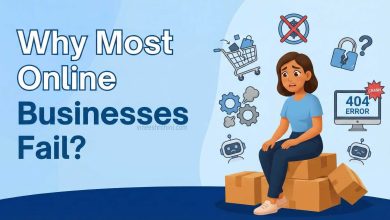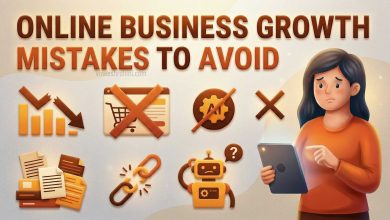Emerging Trends in Online Businesses : A Comprehensive Guide 2025
Emerging Trends in Online Businesses : In 2025, online businesses are evolving at an unprecedented pace, driven by advancements in technology, shifting consumer behaviors, and the growing demand for personalized experiences. From AI-powered solutions and blockchain integrations to sustainable e-commerce and creator-driven platforms, businesses are redefining how they operate and connect with customers. This year promises exciting opportunities for entrepreneurs to innovate, adapt, and thrive in the ever-changing digital landscape. Let’s explore the key trends shaping the future of online businesses in 2025.
Table of Contents
AI-Driven Ecommerce: How AI Tools Are Revolutionizing Online Stores

Artificial Intelligence (AI) continues to reshape the ecommerce landscape in 2025, offering tools that enhance customer experience, streamline operations, and boost profitability. AI tools now power advanced personalization, enabling online stores to deliver tailored product recommendations based on user behavior and preferences. Chatbots, equipped with natural language processing, provide 24/7 customer support, addressing queries instantly and improving user satisfaction
Inventory management has also benefited from AI. Predictive analytics allow businesses to anticipate demand accurately, minimizing stockouts and overstocking. Additionally, AI-powered dynamic pricing tools analyze market trends, competitor prices, and customer demand to optimize pricing strategies in real-time, maximizing revenue and competitiveness.
Moreover, AI enhances marketing efforts through automation and data-driven insights. Tools like AI-generated content and email marketing automation enable businesses to reach the right audience with the right message, boosting conversion rates. As AI technology advances, ecommerce businesses leveraging these tools gain a significant edge in efficiency and customer engagement.
Read more: Top 10 AI Tools for Dropshipping in 2025 : Comprehensive Guide
Sustainable Dropshipping Ideas for 2025

Sustainability has become a crucial factor for consumers, and in 2025, dropshipping businesses are aligning with this trend. Environmentally conscious buyers demand products that reflect their values, making sustainable dropshipping a lucrative opportunity.
Key Sustainable Dropshipping Niches:
- Eco-Friendly Home Products: Items like reusable kitchenware, biodegradable cleaning supplies, and energy-efficient gadgets are increasingly popular.
- Sustainable Fashion: Dropshipping organic cotton clothing, recycled materials apparel, and vegan leather accessories caters to the eco-conscious fashion market.
- Green Beauty Products: Natural, cruelty-free, and zero-waste beauty products are a growing segment in the dropshipping industry.
- Solar-Powered Gadgets: Portable solar chargers, lamps, and energy-efficient devices are practical and appealing to sustainability-focused consumers.
To stand out, sustainable dropshipping businesses must prioritize transparency. Highlighting product sourcing, certifications, and eco-friendly practices helps build trust with consumers. Partnering with ethical suppliers and adopting carbon-neutral shipping practices further enhances credibility. In 2025, businesses that combine sustainability with convenience and affordability can tap into a rapidly growing market.
Profitable Niches in the Creator Economy

The creator economy has experienced explosive growth, driven by individuals monetizing their skills, passions, and content. In 2025, this economy continues to thrive, offering countless opportunities for entrepreneurs and creators to capitalize on emerging trends. Here are some of the most profitable niches:
1. Educational Content and Online Courses
With the growing demand for upskilling and self-improvement, online courses remain a profitable niche. Creators specializing in tech, personal finance, mental health, fitness, and creative skills like graphic design or photography are finding large, engaged audiences. Platforms like Teachable and Udemy allow creators to monetize their expertise while reaching global learners.
To succeed, creators must focus on delivering value and actionable insights. Personalized learning paths, interactive elements, and certifications enhance course appeal. Microlearning—offering short, focused lessons—is gaining traction, catering to time-strapped learners.
2. Niche Communities and Membership Platforms
Community-driven platforms are at the heart of the creator economy. Creators building niche communities around shared interests—such as wellness, parenting, gaming, or entrepreneurship—can monetize through membership fees, exclusive content, and live events. Tools like Patreon and Discord make it easier for creators to foster engagement and provide premium experiences.
Authenticity is crucial in this niche. Successful creators connect with their audience on a personal level, fostering trust and loyalty. Additionally, providing consistent value through exclusive resources, Q&A sessions, and behind-the-scenes content ensures long-term success.
3. Digital Products and Assets
Selling digital products is a low-overhead, high-margin opportunity in the creator economy. Popular digital products include:
- Templates for productivity, graphic design, or business plans.
- Ebooks on niche topics.
- Stock photos, videos, and music for content creators.
- Printable planners and calendars.
In 2025, AI tools are helping creators generate high-quality digital assets more efficiently. For instance, AI-powered design platforms streamline the creation of templates, while tools like ChatGPT assist in writing ebooks or developing course material.
Buy now: 300000+ Online Sellers Mega Database
4. Live Streaming and Interactive Content
Live streaming continues to dominate in areas like gaming, fitness, cooking, and DIY crafts. Platforms like Twitch and YouTube Live allow creators to engage directly with their audience, fostering a sense of community. Monetization options include sponsorships, ad revenue, and viewer donations.
Interactive content, such as live Q&A sessions, workshops, and webinars, enhances engagement and provides opportunities for creators to upsell premium products or services. Integrating AR (Augmented Reality) and VR (Virtual Reality) experiences can further differentiate creators in this space.
5. Affiliate Marketing and Product Reviews
Affiliate marketing remains a reliable income source for creators. By reviewing products or services and including affiliate links, creators earn a commission on sales generated through their recommendations. Niches like tech gadgets, beauty, fitness gear, and software tools are particularly lucrative.
To succeed in affiliate marketing, creators must maintain transparency and credibility. Genuine, in-depth reviews build trust, while strategic partnerships with brands ensure higher commission rates and exclusive offers for their audience.
6. Personal Branding and Coaching
Personal branding is a powerful asset in the creator economy. Individuals who establish themselves as experts in a niche—such as career coaching, personal finance, or mental health—can monetize through one-on-one coaching, group sessions, and online workshops. Platforms like Zoom and Calendly simplify scheduling and communication.
To stand out, creators must develop a strong online presence through consistent content and engagement. Offering free resources or insights as a lead magnet can help attract potential clients and build a loyal following.
Buy now: 300000+ Online Sellers Mega Database
The Future of the Creator Economy
As the creator economy evolves, diversification becomes essential. Successful creators often combine multiple income streams, such as ad revenue, merchandise sales, sponsorships, and crowdfunding. Collaboration with other creators also amplifies reach and opens new monetization opportunities.
In conclusion, the creator economy in 2025 offers immense potential for those who can identify and cater to niche markets. By leveraging emerging platforms, staying authentic, and consistently delivering value, creators can build sustainable and profitable businesses.
Conclusion
The online business landscape in 2025 is brimming with opportunities, driven by technological advancements, changing consumer behaviors, and innovative business models. From e-commerce evolution and AI-powered solutions to sustainable practices and decentralized finance, entrepreneurs have more tools than ever to scale their ventures. By staying informed about emerging trends, adapting to market shifts, and leveraging new technologies, businesses can not only survive but thrive in this dynamic digital era. Whether you are just starting or looking to pivot, embracing these trends can lead to long-term success and growth in the online business world.



